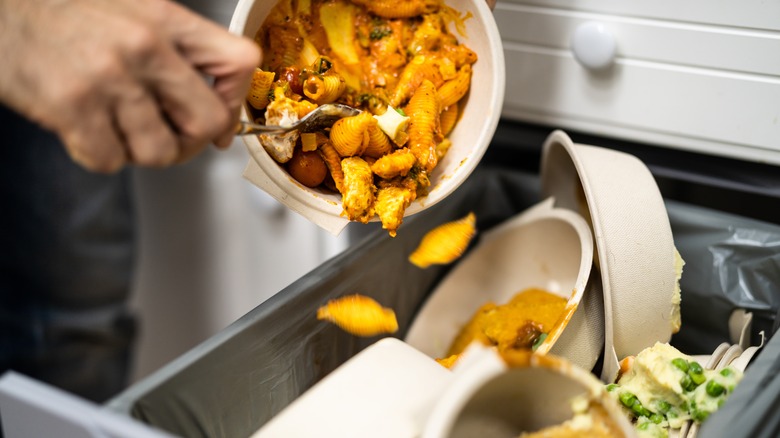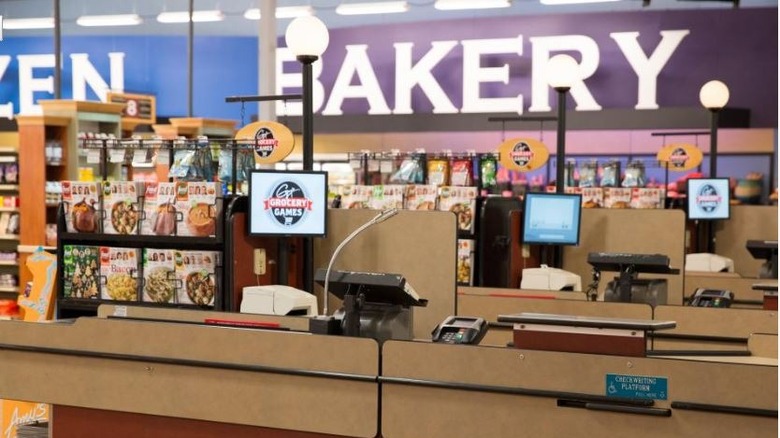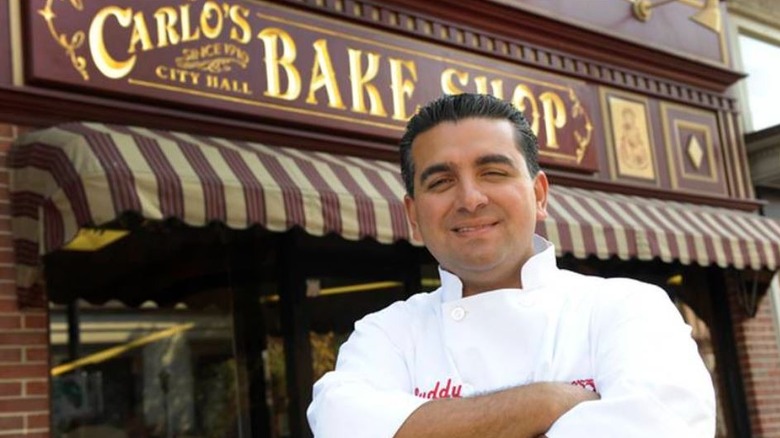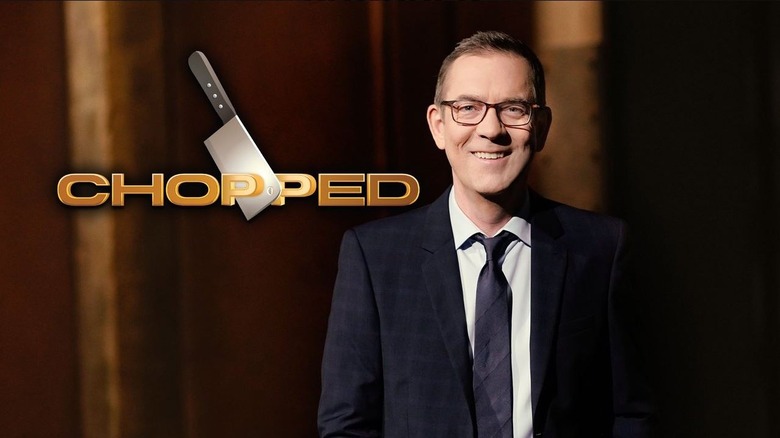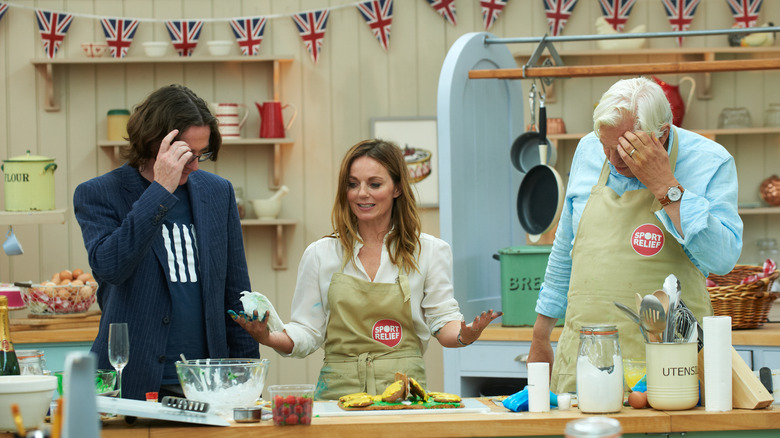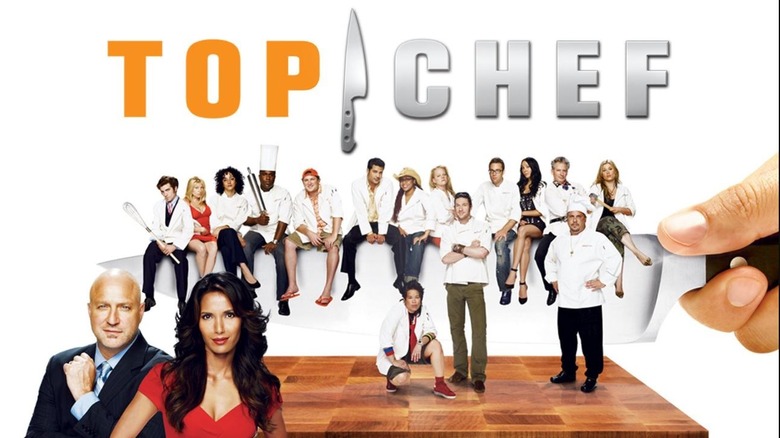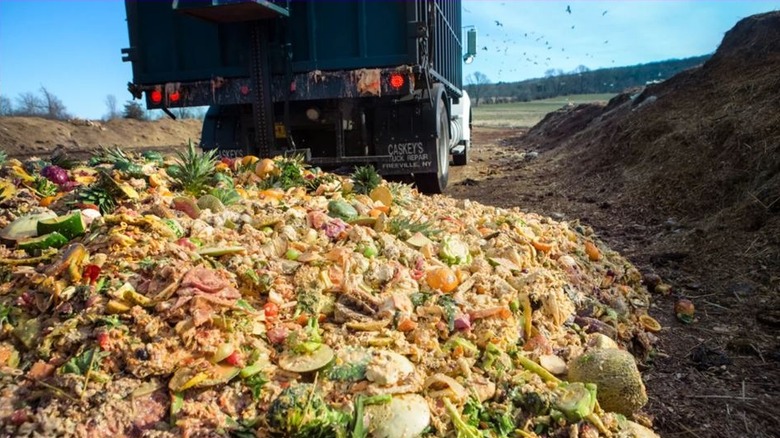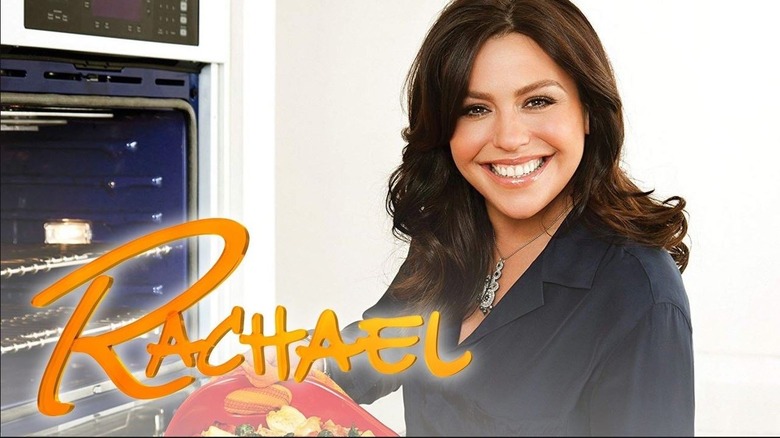What Happens To The Leftover Food On All Of Your Favorite Cooking Shows
We may receive a commission on purchases made from links.
Watching talented chefs perform awe-inspiring culinary feats on TV is a national and international pastime, with shows like "Chopped," "The Great British Baking Show," and "MasterChef" shooting up in popularity in recent years. A Harris poll even found that as many as eight in 10 Americans tune in to cooking shows online or on TV (via Marketing Charts).
But as more cooking shows are gaining acclaim, and the audience sees chefs constantly tossing food in the trash (I'm giving you the nod, Gordon Ramsay), one starts to wonder: What happens to all the food that isn't eaten?
Well, the answer is variable, and it depends widely on the show itself as well as the country in which it is filmed. As it turns out, there are tons of altruistic and creative methods for distributing leftovers on cooking shows, from feeding crew and staff to donating to food banks. Unfortunately, though, there is also a ton of waste.
Guy's Grocery Games
Panicked flights through the dairy section, people taking corners at breakneck speeds, contestants filling their carts with ingredients for a dish to be completed in just minutes. "Guy's Grocery Games" does not conjure up an image of people pausing thoughtfully to weigh or measure their ingredients while mad-dashing down the produce aisle. They grab what they can, and use only what they need for the challenge.
Despite an entire grocery store at the contestants' disposal, amazingly none of the food on this show is wasted. Every week, staff checks grocery items for dates nearing expiration, and if the products are still good, they are donated to food banks. After each challenge, typically three per show with three judges tasting, there isn't a ton of leftover food compared to other shows. Nevertheless, scraps from Triple G go to a local farm for animal feed. Yes, even farm animals get to try these dishes, but we are left to salivate from a distance.
MasterChef US and UK
Some shows have made it an ongoing tradition to donate leftover food to specific charities. On Fox's "MasterChef," you might have been dazzled by the "pantry" (kind of like quaintly calling that $2.8 million beach house the "cottage") where the contestants get to pick their ingredients. Of course, we're all curious where that veritable smorgasbord of delights ends up after filming is over.
As it turns out, the crew gets first dibs, Marketplace reported. All leftovers and unused pantry items are then donated to MEND – a support service charity based in LA. MEND (Meet Each Need with Dignity) has a longstanding practice of serving the neediest people in the Valley community of Los Angeles, collecting and distributing clothing, furniture, and food since 1971.
In the UK-based version of the show, the crew takes their leftovers very seriously, according to The Sun. The raw ingredients (think groceries, uncooked meats, etc.) are given to the younger crew who may not be earning as much, and the completed dishes are divvied up amongst the filming crew. Nothing is wasted!
MasterChef Australia
On the other side of the world (literally), "MasterChef Australia" might take the award for the least waste in the world of cooking shows. According to news.com.au, the food goes through a several-step process to ensure nothing gets tossed. Creatively, the crew regularly put together a collective nomination of an Australian charity, which then gets to take what they like from the "MasterChef" pantry. Whatever is left over after that goes to SecondBite, an organization that "rescues food to feed hungry Aussies" and gives it to over 1,400 Australian charities. They collect the surplus food from growers, manufacturers, and retailers, and of course, "MasterChef Australia," which has been donating its pantry goods to SecondBite since 2013.
Finally, the waste that is left after all the edible goodies have been claimed gets composted in their own machine that ultimately feeds the "MasterChef" garden. The whole process is a self-sustaining wonder that wastes absolutely nothing.
Cake Boss
TLC's "Cake Boss" is one show that had a bit of notoriety surrounding their treatment of leftovers. In 2014, according to the LA Times, a charity event supporting Wrigley Field's 100th anniversary featured a monstrous 400-pound cake made by the Cake Boss bakery depicting the famous baseball stadium. Since it had been on display several hours earlier that day at a Cubs game, then transported to the event, the organizers erred on the side of caution and opted to trash the cake (because food poisoning at a charity event is probably bad optics). Not a disagreeable plan on the whole, unless you count the guy who documented the entire dismantling-by-forklift on Reddit.
Trashing leftover food is unfortunately quite common. Most cooking shows can take 12 to 14 hours of filming in a day, which means a lot of food is left out longer than is feasibly safe to eat.
Chopped
Featuring a 30-minute or less timeline for the completion of dishes based on oddball ingredients in a mystery basket, you would think the fast pace on "Chopped" would lead to plenty of fresh, hot food. Yahoo! shared in an interview with Ted Allen that actually, the frenetic energy of the show is broken down from a 12-hour workday of shooting. Because of the length of time needed for filming, the judges are often tasting cold dishes by the time the audience sees them tasting them. The judges do, however, try elements of the dish immediately after time is called, when they are hot and fresh.
The leftovers are tossed after they've been sitting out for a while, so that is one repercussion that comes from high-quality filming and editing. But don't fret; even though Ted Allen never seems to eat on the show, he does sneak bites off camera.
The Great British Bake Off and Cupcake Wars
In baking shows, the protocol for leftovers can widely vary. BBC Good Food interviewed chief home economist Faenia Moore of "The Great British Bake Off," who said, "It's important for the bakers to eat what they've slaved over." Each challenger receives a "baker's basket" filled with their delectable creations, and the remainder of the leftovers are gifted to the crew.
In a different vein, on "Cupcake Wars" (which ran from 2009 to 2018), with the towering cupcake creations assembled, more waste was created due to extended periods of time at room temperature. Occasionally, when the cupcakes were made for special events and charity offerings, they would be allowed to keep the elaborate and painstakingly detailed fondant creations. Unfortunately, though, the cake part would need to be remade (again, bacteria and stale edibles are typically frowned upon) and the original confections were dumped. To be fair, however, some of these masterpieces could be defined as art more than pastry, so all is forgiven.
Top Chef
Dream jobs can come with many different types of perks, but being able to retire back to your hotel after a rewarding day producing and have regular dinner parties highlighting caviar and foie gras just might challenge that annual Christmas bonus in terms of awesomeness. The "Top Chef" culinary producers may not donate to any charities, but they certainly eat well. According to host Padma Lakshmi, she regularly expects a 10-pound weight gain each season in preparation for all the impeccably crafted noms.
Luckily, since all the meals featured on the show are created specifically for the judges, there is little-to-no food waste. After everyone has a chance to enjoy the handiwork of highly competitive chefs, they only have to junk the food that spoils during filming. Of course, as any exhausted cook will know, most of the participants tend to rely on ramen and peanut butter and jelly sandwiches after an interminable day on set. Who wants to cook anything after that?
The Big Waste
Food Network itself shines a spotlight on the astonishing amount of food excess in America with "The Big Waste." The same stars that host "Chopped," "Iron Chef," and "Worst Cooks in America" put on center stage the sheer, horrifying numbers (note: 37 TONS) of edibles wasted in America each year. They document their discoveries of perfectly edible scavengings from stores and restaurants, and band together to compete amongst themselves with ingredients that would otherwise have been tossed.
This show is a great observation that illuminates how much people and companies throw out. The results from America's food waste are palpable, but seeing the resulting conversation on social media brings some hope to the future of the situation. A lot of people are paying more and more attention to how much they are cooking, with special attention to preservation, using leftovers in new dishes, and using what they already have on hand.
The Rachael Ray Show
As we have come to recognize as a fairly common practice, "The Rachael Ray Show" shares the tradition of giving leftover creations to the crew. Insurance rules prohibit the show from sharing the finished meals with the live studio audience, but the show also partners with City Harvest, an organization that correlates the overabundance of wasted food in New York City with the 1.5 million hungry people who live there and does an amazing job of filling that need. City Harvest has donated and delivered 153 million pounds of rescued food (things labeled "imperfect" by some, but entirely good to eat) annually to food pantries and soup kitchens throughout New York since 1982.
There are many perspectives from which you can view the food system in America. History shows that the "waste not want not" attitude has fallen with the rise of industry, but thankfully, insight is beginning to prevail. We are beginning to see the situation as it is: something curable with some ingenuity, creativity, and kindness.
